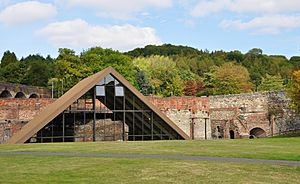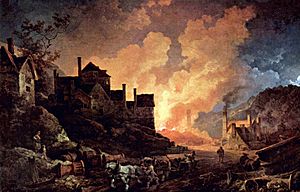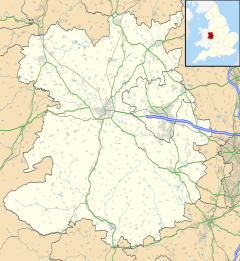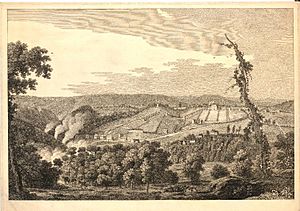Coalbrookdale facts for kids
Quick facts for kids Coalbrookdale |
|
|---|---|
 Abraham Darby's blast furnace, Coalbrookdale |
|
| OS grid reference | SJ668047 |
| Civil parish | |
| Unitary authority | |
| Ceremonial county | |
| Region | |
| Country | England |
| Sovereign state | United Kingdom |
| Post town | TELFORD |
| Postcode district | TF8 |
| Dialling code | 01952 |
| Police | West Mercia |
| Fire | Shropshire |
| Ambulance | West Midlands |
| EU Parliament | West Midlands |
| UK Parliament |
|
Coalbrookdale is a small village in Shropshire, England. It's part of the famous Ironbridge Gorge area. This village is very important in history. It's where the Industrial Revolution really took off.
A man named Abraham Darby first used a special type of coal here. This "coking coal" helped him make iron much better. This discovery changed how things were made forever. Today, Coalbrookdale is home to the Ironbridge Institute. This institute teaches people about heritage and history.
Contents
Coalbrookdale's Early Iron History
Before the 1700s, Coalbrookdale already had ironworks. These were called "bloomsmithies." The land belonged to a priory (a type of monastery) before it was taken over by the King. Later, a family named Brooke owned the land. They started mining a lot of coal.
Sir Basil Brooke was an important industrialist. He likely had ironworks in Coalbrookdale too. He even worked on a way to make steel. His works continued even during the English Civil War.
In 1651, the ironworks were leased to Francis Wolfe. He and his son ran them. There's an old date on a furnace lintel. It might say 1638 or 1658. This makes the exact history a bit unclear. By 1688, Lawrence Wellington ran the ironworks. Later, Shadrach Fox took over. He made cannonballs and grenade shells for the army. But in 1703, the main furnace blew up! It stayed broken until Abraham Darby the Elder arrived in 1709.
The Industrial Revolution Begins Here

In 1709, Abraham Darby I rebuilt the Coalbrookdale Furnace. He started using coke as fuel. Coke is made from coal. This was a huge step forward. Darby was very good at making cast-iron pots and other goods. His special method made them cheaper than anyone else's.
Coalbrookdale is famous for having the first successful coke-fired blast furnace in Europe. This furnace worked well for many years. Darby formed a new business partnership in 1714. They even planned to build more furnaces. Sadly, Darby died young in 1717.
His son, Abraham Darby the Younger, later joined the business. The company mainly made cast-iron items. They also made parts for early steam engines. Around 1754, they found a way to use coke-made iron to create wrought iron. This led to building new furnaces nearby. It was the start of a huge growth in ironmaking.
In 1767, the company began making the first cast-iron rails for railways. Then, in 1778, Abraham Darby III built something amazing. He built the world's first cast-iron bridge. This famous bridge is called The Iron Bridge. It opened on January 1, 1781. Many people think the iron-making happened in the village of Ironbridge. But most of the work was actually done right here in Coalbrookdale.
The industrial growth in Coalbrookdale continued. They built clever systems of ponds and pipes. These helped provide water power for the machines. They even had a special engine to reuse the water.
In 1795, a porcelain factory opened nearby in Coalport. It made beautiful Coalport porcelain.
In 1802, the Coalbrookdale Company built a steam locomotive. It was for Richard Trevethick. We don't know much about it, or if it ever ran. A worker was hurt in an accident with the engine. This might have stopped the company from using it.
In the 1800s, Coalbrookdale became known for its fancy ironwork. For example, the gates of London's Hyde Park were made here. You can also see their work in Monmouth, Wales, and even in New Zealand. The blast furnaces closed down around the 1820s. But the foundries kept making iron goods. The Coalbrookdale foundry finally closed in November 2017.
Today, you can visit many historic sites in Coalbrookdale. These include the old railway station, the Quaker Burial Ground, and the Darby Houses.
Coalbrookdale Museum of Iron
After the Old Blast Furnace closed, it got buried over time. People decided to dig it up and save it. In 1959, a small museum opened to celebrate 250 years of the company. This grew into the larger Ironbridge Gorge Museums.
The Museum of Iron is in a big building from 1838. The Ironbridge Institute is in another long building. These two buildings stand around the Old Blast Furnace. The furnace is now inside a special building built in 1981. This protects it from the weather. The museum's archaeology team still studies Coalbrookdale's past. They recently found parts of a 17th-century steel-making furnace.
The Old Furnace
The Old Furnace started as a regular blast furnace. But in 1709, Abraham Darby I began using coke in it. He used it to make cast-iron pots and kettles. His grandson, Abraham Darby III, used iron from this furnace to build the first Iron Bridge.
The furnace has dates carved into its stone parts. The top one says "Abraham Darby 1777." This was likely when it was made bigger for the Iron Bridge. A lower date is either 1638 or 1658. The inside of the furnace is shaped to make iron molten. When Abraham Darby III made it bigger, he only widened some sides. This was because a water wheel was in the way. So, the furnace's opening is a bit off-center.
In the 1720s and 1730s, the furnace mainly made cooking pots and other household items. It also made cylinders for steam engines. Later, in the late 1700s, it made iron for big structures. This included the Buildwas Bridge in 1795. This bridge used less iron than the Iron Bridge, even though it was wider. In 1796, Thomas Telford built the Longdon-on-Tern Aqueduct. It carried a canal over a river. It was supported by cast-iron columns from Coalbrookdale.
In the 1800s, fancy ironwork became a special product. Coalbrookdale made beautiful decorative pieces.
Famous People from Coalbrookdale
- Abraham Darby II (1711–1763), a famous ironmaker, and his wife Abiah Darby (1716–1794), a Quaker speaker.
- Abraham Darby III (1750–1794), another important ironmaker.
- Arthur Charles Fox-Davies (1871–1928), a writer and expert on heraldry (family symbols).
See also
 In Spanish: Coalbrookdale para niños
In Spanish: Coalbrookdale para niños





